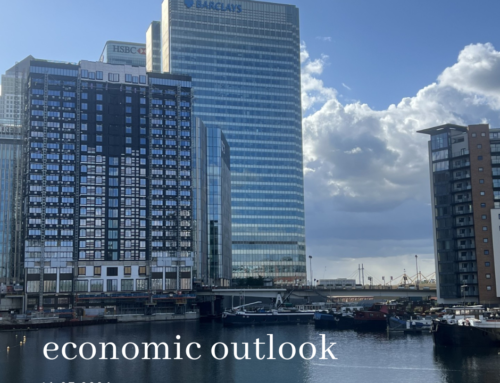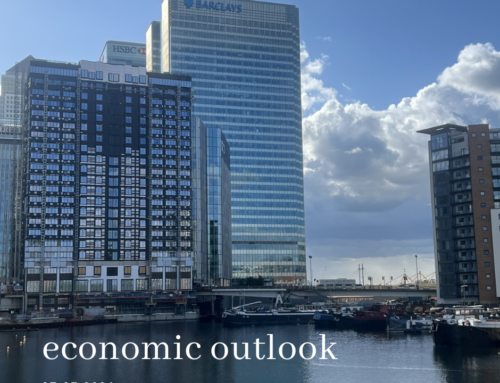| USA The S&P Global Flash Composite PMI slipped from 52.5 in February to 52.2 in March, a level that nonetheless remains consistent with a healthy improvement in private sector operating conditions. New orders and output continued to expand, albeit at a slower pace than in the prior month. That did not prevent employment from growing at the fastest rate in 2024 so far. On a less positive note, cost pressures gained momentum, as indicated by the steepest increase in output charges since April last year, something polled businesses attributed to higher material and fuel costs and greater wage bills. Rising prices did not, however, seem to have affected prevailing optimism, with survey respondents displaying the highest degree of confidence in future output since May 2022 The drop in the composite PMI was driven by services, with the associated gauge sliding from 52.3 to a three-month low of 51.7. Incoming new business piled up at a slower pace in the month. The manufacturing gauge, meanwhile, rose from 52.2 to 52.5, marking the third consecutive improvement in factory activity and the sharpest since June 2022. Output grew the most in 22 months, while employment expanded at the fastest clip since July The Conference Board’s index of leading economic indicators (LEI) eked up 0.1 point in February to 102.8, marking the first in-crease for this indicator in more than two years. Seven of the ten underlying economic indicators contributed positively to the headline index, led by average workweek (+0.18 percentage point), stock prices (+0.17 pp), and the leading credit index (+0.08 pp). Historical analysis shows that an annualized drop of 3.5% in the LEI index over six months, coupled with a six-month diffusion index below 50%, is generally symptomatic of a pending recession. Both of these conditions were met in February: The LEI index fell 5.1% annualized over six months and the six-month diffusion index stood at 30%. After being slowed down by inclement weather in January, housing starts rebounded strongly in February, moving from 1,374K (initially estimated at 1,331K) to 1,521K. This was significantly above the median economist forecast calling for a 1,440K print. The jump reflected improvement in both the single-family segment (+11.6% to a 22-month high 1,129K) and the multi-family segment (+8.3% to 392K) The housing sector, which has felt the brunt of a stagging rise in borrowing costs, has shown signs of life lately. Existing home sales and housing starts both left expectations in the rearview mirror. Moreover, the starts data reflect some rebalancing in the marketplace as single-family starts continue to grind higher adding units to a market starved for supply, while the multifamily segment slows down. Looking forward, increasing permitting activity suggests that there is some more room for improvement in housing construction The US Federal Reserve held the benchmark federal funds rate steady in the range of 5.25% to 5.50% at this week’s Federal Open Market Committee meeting but reiterated that it still expects a cumulative 0.75% in rate cuts in 2024. This stance on cuts was perceived as dovish by the market as both GDP and core inflation estimates were revised up for the year. Despite the three 25-basis-point rate cuts envisioned for this year, longer-term dot-plot projections indicated a slower pace of cuts moving forward as Fed Chair Jerome Powell said the path back to 2% inflation is likely to be bumpy. The Fed made no decisions on the balance sheet; however, it communicated that it is likely to slow the pace of balance sheet runoff soonStocks moved higher for the week, pushing the S&P 500 Index and the Nasdaq Composite to new records, as investors welcomed news that Federal Reserve policymakers were still anticipating three interest rate cuts later in the year. Communication services led the gains along with technology shares. A late rise helped artificial intelligence chipmaker NVIDIA reach a record high on Friday and lift the company’s market capitalization near USD 2.4 trillion. Reports that Apple might partner with Google parent Alphabet in offering generative artificial intelligence tools also boosted sentiment. Health care and real estate shares lagged. Trading the following week was scheduled to end on Thursday in observance of the Good Friday holiday In terms of data release, Durable Goods Orders are out on Tuesday. Over the past year, business equipment spending has been weak and consumer demand has pivoted away from durable goods. These dynamics have weighed on the factory sector. Yet similar to the housing market, production appears poised for growth this year as borrowing costs eventually ease. In January, orders of durable goods contracted 6.2%, but most of that decline can be attributed to nondefense aircraft orders. Aircraft sales data from Boeing show net new orders modestly picking up in February after plummeting to zero in January. The rebound will likely boost total durable goods orders Personal Income and Spending is out on Friday. After a blockbuster year for consumer spending, households may finally be hitting the brakes. Real consumer spending slipped 0.1% in January, which was corroborated by a 1.1% contraction in retail sales over the month. On the income side, real personal disposable income was flat. The lackluster outturn was in part driven by a strong gain in prices. The core PCE deflator rose 0.4% in January, which was the largest increase in a year. UK GfK’s consumer confidence metric registered at -21 in March, flat compared to February but 2pp below market expectations. Issues relating to the cost of living along with wider economic uncertainties continue to dampen sentiment in the UK, although a couple of the forward-looking indicators suggest some slightly better news. Indexes measuring confidence in personal finances over the next 12 months increased as well as the measure looking at the general economic situation over the next year Retail sales figures for February are fairly unremarkable although they are notably better than market expectations. Sales volumes were estimated to be 0% MoM, following an increase of 3.6% in January. December saw a large fall in sales, which was subsequently corrected in January. At the time, there were some concerns that December’s print could indicate a worrying trend, but January and February’s prints suggest that it was merely a seasonal blip. Retail sales volumes gradually declined from the middle of 2021 for around two years but have effectively plateaued from that point onwards The Bank of England’s Monetary Policy Committee held rates steady at 5.25%, although the voting breakdown of eight members voting for a freeze in rates and one voting for a decrease represents a slight “dovish pivot”. MPC members Haskel and Mann, who voted to hike rates at the February meeting, ended up voting along with six other MPC members to hold rates. However, the BoE’s overall positioning is fairly similar to the February meeting. The Committee will continue to closely monitor indications of persistent inflationary pressures and seek to keep under review how long Bank Rate should be maintained at its current level of 5.25%. All eight members voting for a freeze in rates agree that further evidence of progress in bringing down nominal wage growth and services inflation is required before they can vote to decrease rates, although there are differences of views relating to the extent of evidence needed to start making monetary policy less restrictive Given the Monetary Policy Committee’s remit is to keep inflation at a target level of 2%, recent history has left the committee naturally cautious. While yesterday’s inflation figure for February, 3.4%, came in marginally below expectations, the consensus view among the committee clearly favors waiting for more evidence of easing price pressures before voting to cut rates. BoE Governor Bailey said earlier this week: “we need to see more evidence that inflation is set to fall all the way to the 2% target, and stay there, before we can lower interest rates.” This clearly indicates that while UK CPI inflation is set to fall below 2% in just a few months’ time, the BoE is waiting for evidence that price growth will stay at these levels in the medium term. EU The PMI flash composite output index was 49.9 in March, up from 49.2 in February and in line with expectations of 49.7. Under the hood, however, Manufacturing PMI plummeted to 45.7, down from 46.5 in February and well below expectations of 47.0. Eurozone Services PMI, on the other hand, was 51.1, up from 50.2 and above expectations of 50.5. The difference between Manufacturing and Services PMI was even greater on a country level: While Germany composite was in line with the Bloomberg Survey, Manufacturing PMI fell to 41.6 from last month’s 42.5 and far short of expectations of 43.0. Germany Services PMI rose to 49.8 from 48.3, far exceeding expectations of 48.8. France fell short of expectations in both categories, resulting in a Composite PMI well below expectations, with Manufacturing PMI weighing the heaviest. The weak manufacturing data, which usually leads PMI-changes, is a reminder to the ECB of the stern current financial conditions. And while the data is not nearly dramatic enough to entice a rate cut before long-anticipated wage data, it is weighing on the decision to cut rates sooner rather than later. This flash indicates a cooling Eurozone economy, but longer-term inflationary pressures are still present and need to cool down further. The Swiss National Bank (SNB) unexpectedly reduced borrowing costs by a quarter of a percentage point to 1.5% (the first cut in nine years). The SNB said that it aimed to address lower inflationary pressure and an appreciation of the Swiss franc In local currency terms, the pan-European STOXX Europe 600 Index ended near a record high, climbing 1.03%. Dovish signals from central banks boosted risk-on sentiment. Germany’s DAX gained 1.58%, while Italy’s FTSE MIB advanced 1.30%. France’s CAC 40 Index, however, fell 0.17%. CHINA Chinese banks left their one- and five-year loan prime rates unchanged at 3.45% and 3.95%, respectively, as expected, after the People’s Bank of China kept its medium-term lending rate on hold the prior week. Many analysts anticipate that the central bank will continue to loosen policy and further reduce its reserve requirement ratio after a surprise cut in January to boost demandIndustrial production rose an above-forecast 7% in January and February from a year earlier, up from December’s 6.8%. Fixed-asset investment grew 4.2% in the first two months of the year from the prior-year period, rising from 3% in December amid higher infrastructure growth. Retail sales rose more than expected over the two-month period as consumption surged during the weeklong Lunar New Year holiday but eased from December’s increase. The urban unemployment rate was 5.3%, while the youth jobless rate edged up to 15.3% Property investment in China fell by 9% in the January–February period from a year earlier, slowing from a 24% drop in December, according to official data. Property sales by floor area sank 20.5% in the first two months of the year, after slumping 23% in December. The slower pace of declines in property investment and sales came after Beijing rolled out numerous pro-growth measures to arrest the country’ yearslong real estate slump. However, most investors remain cautious about China’s property sector as developers continue to grapple with high debt levels and weak homebuyer demand Chinese equities retreated as concerns about the property sector slump offset optimism about better-than-expected economic data. The Shanghai Composite Index declined 0.22%, while the blue-chip CSI 300 gave up 0.70%. In Hong Kong, the benchmark Hang Seng Index lost 1.32%, according to FactSet. |
| Sources: T. Rowe Price, MFS Investments, Wells Fargo, Handelsbanken Capital Markets, TD Economics, National Bank of Canada, M. Cassar Derjavets. |


